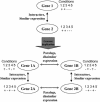Functional divergence of duplicated genes formed by polyploidy during Arabidopsis evolution
- PMID: 15208398
- PMCID: PMC514153
- DOI: 10.1105/tpc.021410
Functional divergence of duplicated genes formed by polyploidy during Arabidopsis evolution
Abstract
To study the evolutionary effects of polyploidy on plant gene functions, we analyzed functional genomics data for a large number of duplicated gene pairs formed by ancient polyploidy events in Arabidopsis thaliana. Genes retained in duplicate are not distributed evenly among Gene Ontology or Munich Information Center for Protein Sequences functional categories, which indicates a nonrandom process of gene loss. Genes involved in signal transduction and transcription have been preferentially retained, and those involved in DNA repair have been preferentially lost. Although the two members of each gene pair must originally have had identical transcription profiles, less than half of the pairs formed by the most recent polyploidy event still retain significantly correlated profiles. We identified several cases where groups of duplicated gene pairs have diverged in concert, forming two parallel networks, each containing one member of each gene pair. In these cases, the expression of each gene is strongly correlated with the other nonhomologous genes in its network but poorly correlated with its paralog in the other network. We also find that the rate of protein sequence evolution has been significantly asymmetric in >20% of duplicate pairs. Together, these results suggest that functional diversification of the surviving duplicated genes is a major feature of the long-term evolution of polyploids.
Figures





Comment in
-
Two genomes are better than one: widespread paleopolyploidy in plants and evolutionary effects.Plant Cell. 2004 Jul;16(7):1647-9. doi: 10.1105/tpc.160710. Plant Cell. 2004. PMID: 15272471 Free PMC article. Review. No abstract available.
References
-
- Acarkan, A., Rossberg, M., Koch, M., and Schmidt, R. (2000). Comparative genome analysis reveals extensive conservation of genome organisation for Arabidopsis thaliana and Capsella rubella. Plant J. 23, 55–62. - PubMed
-
- Arabidopsis Genome Initiative (2000). Analysis of the genome sequence of the flowering plant Arabidopsis thaliana. Nature 408, 796–815. - PubMed
Publication types
MeSH terms
Substances
LinkOut - more resources
Full Text Sources
Other Literature Sources

